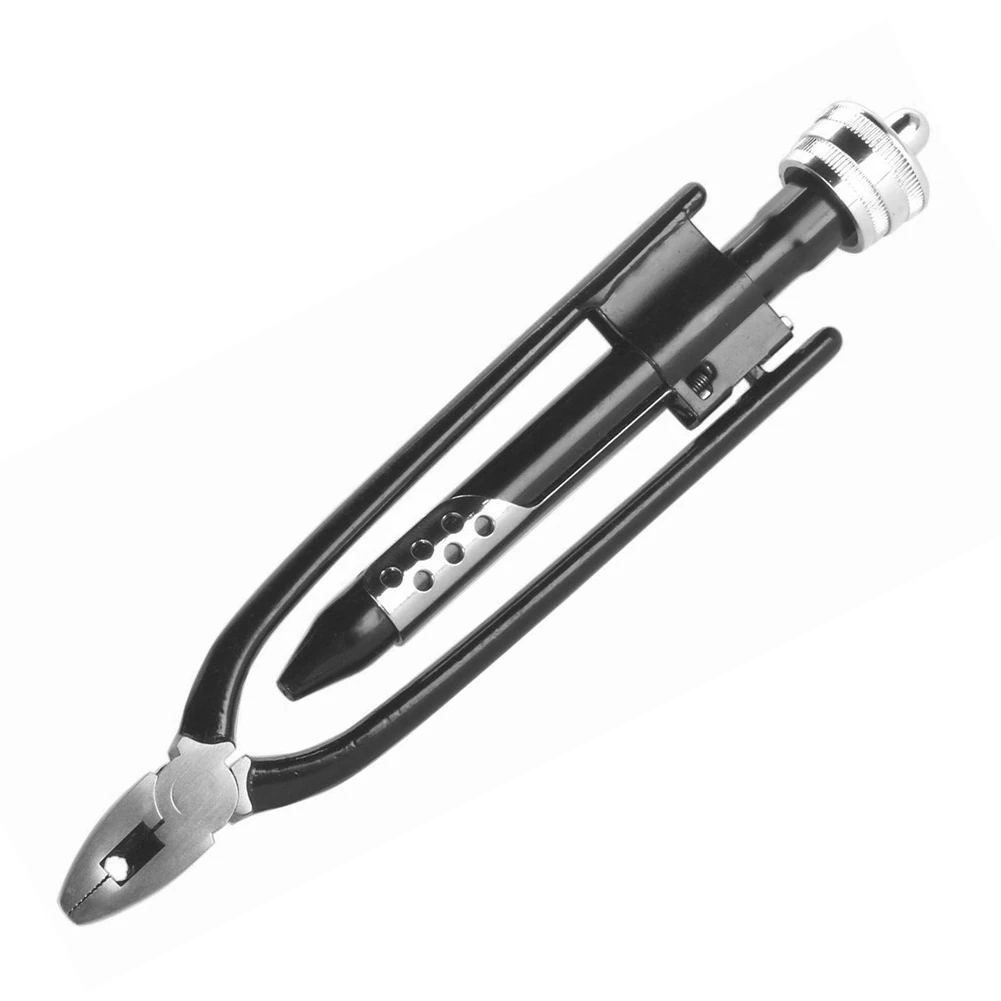Aircraft Structures Tools - Before repair parts are installed in the aircraft, the new parts must be measured and marked, otherwise the measurements required to make the repair part are placed. The tools used in this process will be discussed in this section.
Scales Scales come in a variety of lengths, with 6-inch and 12-inch scales being the most common and most affordable. A scale with fractions on one side and decimals on the other is very useful.
Aircraft Structures Tools
To get an accurate measurement, hold the scale at the edge instead of the end at the 1-inch mark. Place a divider or compass using the graduation mark on the page. [Figure 1]
Aviation Maintenance Technician
The combination square consists of a three-headed steel weight that can be moved and locked in any weight position. The three heads are a stock head that measures 90° and 45° angles, a protractor that can measure any angle between the head and the blade, and a center head that uses one side of the blade as a 90° angle bisector. . The center of the shank can be found using the center head. Place the end of the shaft in the V of the head and draw a line along the edge of the weight. Turn the head 90 ° and draw another line along the edge of the weight. The two lines intersect in the middle of the shaft. [Figure 2]
Divisors are used to transfer from the unit to the scale to determine the measurement value. Sharp points are placed at the measurement locations. Then place the dots on the steel machinist's scale, but place one of the dots on the 1-inch mark and measure from there. [Figure 3]
A rivet spacer is used to create a quick and accurate rivet pattern on the panel. There are markings on the rivet connectors for 1⁄2-inch, 3⁄4-inch, 1-inch, and 2-inch rivet spacing. [Figure 4] Whether it is a wing, wing box or other aircraft component, drilling large holes in an aircraft structure is neither easy nor cheap. A cutting tool with a diameter of 12.7 to 38.1 mm (0.5 to 1.5") or more, primarily drills and shears, used to drill, open, and drill holes in various stacked and clamped materials such as coal, glass-reinforced plastic, aluminum and titanium.
To complete this process, aerospace engineers and shop workers often use long and expensive tools such as solid carbide to drill the relatively small number of holes required for each structure, resulting in very high costs per good hole.
Aircraft Mechanic Resume Example
For drilling piling material, flat mounting drills with a diameter of 12.7 to 38.1 mm or more are used.
Process costs include setup time, tool change time, tool price, and the logistics of producing a solid drill bit that takes at least twice as long as a modular drill head. YG-1 Tool (USA) of Vernon Hills, Illinois, introduced its newly designed modular drill and body to the aerospace market to reduce costs. These modular drills retain the existing geometry that has been successfully produced by monolithic drilling, but at a lower cost. Although the drill head and drill body cost 50% more than solid drills, head replacement is 75% to 90% cheaper than solid drills.
There are three main added values behind the modular rig concept for end users such as aircraft original equipment manufacturers, Tier 1 suppliers and other manufacturers.

Abdelatif Attarsia, based in Charlotte, North Carolina, is global area manager for composites and aircraft assembly at YG-1 Tool (USA) in Vernon Hills, Illinois. For more information on the company's cutting tools, visit www.usa.com or call 800-765-8665. These include rivet cutters, rippers, hand riveters, counters and countersinks.
Solutions For The Aerospace Industry
A rivet cutter is used to cut rivets when there are no rivets of the required length. [Figure 1] To use a rotary rivet cutter, insert the rivet into the correct hole, place the required number of shims under the rivet head, and squeeze the cutter like a pair of pliers. The rotation of the disc cuts the rivet and gives the correct length, which is determined by the number of glasses placed under the head. When using a large rivet cutter, place it in the package, insert the rivet into the appropriate hole, pull the handle and it cuts the rivet. If regular rivet cutters are not available, diagonal cutters can be used as a substitute.
Filling bar, sometimes called dolly, roll bar, roll block, roll bar is a heavy piece of steel whose counter-vibration during installation contributes to the correct installation of rivets. They come in a variety of shapes and sizes and weigh from a few ounces to 8 or 10 pounds, depending on the job. The packing is usually made of hardened low carbon steel or alloy steel. Made of better quality steel, it is durable and requires less maintenance.
The filler surface must be hard enough to resist failure and remain smooth, but not hard enough to crack. Sometimes more complex bars need to be forged or erected by welding. The rod usually has a concave surface to match the shape of the workshop head. When choosing a shard, the first thing to think about is the shape. [Figure 2] If the rod is not in the right shape, the rivet head is deformed; if the rod is too light, it does not provide the necessary weight and the material may bulge into the workshop head. If the bar is too heavy, its weight and bending force will cause the material to bulge out of the tool head.
This tool is used by holding the end of the rivet handle when forming the workshop head. Always hold the face of the button at right angles to the rivet handle. If you don't, the rivet shank will bend with the first stroke of the rivet gun and dull the material with the last stroke. The booker must hold the mounting rod until the rivet is fully driven. If the mounting crossbar is removed while the gun is in operation, the rivet can be driven through the material. Let the weight of the structure do most of the work and don't overload the rivet handle. The driver's hand only guides the bar and provides the necessary tension and bounce action. A regulated hammer causes the rifle to vibrate at the same time as the pack. With experience, advanced skills can be developed.
Typical Repairs For Aircraft Structures (part 1)
Damage to the rivet head can be caused by improper vibration, use of levers that are too light or too heavy, or failure to hold the rivet head at the correct angle. The bars must be clean, smooth and well polished. Their edges should be slightly rounded so as not to damage the surrounding material.
The Hand Rivet A hand riveter is a tool equipped with a chuck to drive specific types of rivets. There is the rivet to fit all sizes and shapes of the rivet head. A simple set is about 6 inches long, made of 1⁄2-inch carbon tool steel and bent to prevent slipping in the hand. Only the surfaces of the kit are hardened and polished.
The universal rivets are countersunk (or cupped) to fit the rivet head. When selecting a suitable set, ensure that there is sufficient space between the rivet head and the side, and between the metal and the surface of the set. A flush or flat set is used for second and flat fifths. The mounting kit must be at least 1 inch in diameter to ensure proper installation of the countersunk rivets.

A special drawing set is used to draw the sheets to remove the holes between the rivets before they are broken. Each puller set has a hole 1⁄32 inch larger than the diameter of the rivet shank it is made from. Sometimes a puller set and a rivet head are combined into one tool. The head consists of a rivet and a hole shallow enough to expand the head when hammered.
Modular Drills Provide Advantages
Countersink Tool A countersink tool is a tool that cuts a conical recess around the rivet hole, allowing the rivet to sit flush with the surface of the skin. It is made at an angle to accommodate the different angles of the installed rivet head. A standard counter has an angle of 100º as shown in Figure 3. Special micro stops (commonly called stop counters) are adjustable to the desired depth, have cutters and can be used to create interchangeable holes for different angles. [Fig
Aircraft structures mechanic, aircraft composite structures, aircraft financing structures, miami aircraft structures, aircraft structures jobs, aircraft tools, aircraft structures technician, aircraft structures mechanic jobs, aircraft composites structures, aircraft structures, aircraft structures book, aircraft structures pdf


0 Comments